-
In geometrical linear crossings of heptagon and diheptagon it is possible to construct proportional patterns of ideal human bodies not only in frontal face-to-face projections, that is told on the first page in this section of website, but also in lateral projections or otherwise to tell perspectives. In both cases linear networks of heptagon and derivative heptagonal geometrical figures are parameters of mathematical ratios and proportions which correspond to ideal measurements and sizes of body shapes, that is shown on drawing plans.
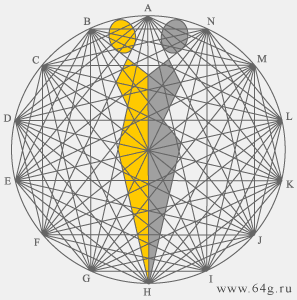
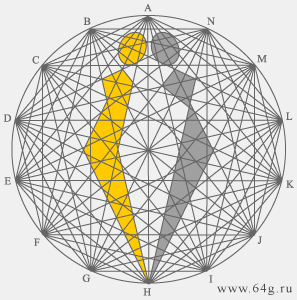
The left plan shows two human figures which correspond to geometrical
patterns of ideal proportions of body shapes.
Both figures can correspond to proportions of male and female bodies, namely
actual somatic parameters have no basic sexual distinctions. But yellow figure
has the high waistline and not big buttocks, and grey figure has low waist and
big buttocks, that can be considered as attributes of proportional features in
male and female body shapes.
The right plan too shows two yellow and grey human figures which correspond to
geometrical patterns of ideal corporal shapes, but each figure corresponds with
proportions of a female body.
The shown four figures have different outlines, but in any case they are
geometrical patterns according to which in view of fine arts it is possible to
draw images or pictures of human bodies with ideal sizes of mathematical ratios
and proportions, as drawings will correspond to measurements of the diheptagonal
linear network.
The shown patterns are elementary as outlines allow to calculate only key lines
of the thigh (hips) and trunk, but diheptagonal linear network can be united
with lines of quadraheptagonal network and then in view of fine arts it is
possible to calculate and draw more complex outlines of body shapes in lateral
or face-to-face geometrical projections, that is shown on following plans.
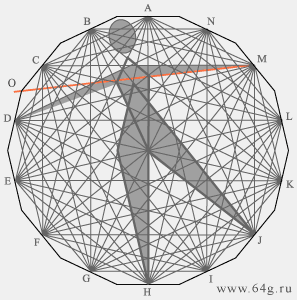
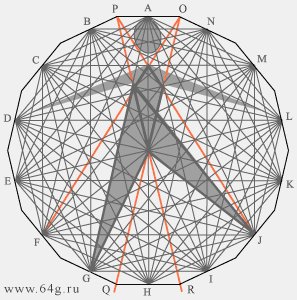
-
The left plan shows an ideal pattern of human figure according to lines of
diheptagonal network, but outlines of one hand are calculated according to
quadraheptagonal linear network, that is shown by red line OM. Namely point M
corresponds with geometry of diheptagon, and point O corresponds to geometrical
measurements of quadraheptagon which actually is connection of two diheptagons
or four heptagons.
The right plan shows a similar ideal pattern of bodily human figure which has
other position in space of quadraheptagonal linear network but consists of same
geometrical modules which are shown by thick lines.
The module of trunk in the left plan is formed by crossing of lines IB-FA-BK-AH
of diheptagonal network, and this module in the right plan is formed by crossing
of lines RP-FO-PJ-OQ which correspond with the linear network of
quadraheptagonal geometrical figure.
More complex crossings of lines in quadraheptagonal network allow in view of
fine arts to draw more various positions of proportional patterns of human
bodies in space.
Pay attention that modules of trunk in the left and right plans have
different vertical sizes, and consequently the right pattern can be considered
as a body which is inclined forward or back, as physical inclination of corporal
shapes reduces the visible vertical size.
If linear crossings of two or four heptagons are insufficient for
calculations and drawing of ideal corporal proportions of geometrical positions
or spatial poses of human bodies in view of fine arts then it is possible to use
in addition the triheptagonal linear network, that is shown on following plans.
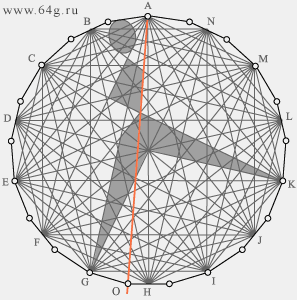
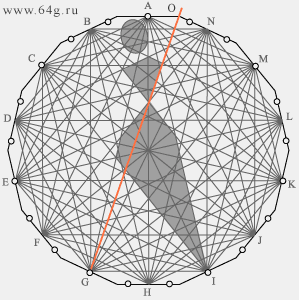
-
Left plan shows the pattern of ideal human figure in which the module of
trunk is formed by linear crossing AO-KC-FA-BK where lines KC-FA-BK correspond
with diheptagonal network, and red line AO corresponds to geometrical
combination of linear networks of diheptagon and triheptagon. Namely the point O
is belong to triheptagon, and measurements of two linear networks are
connected in the point A.
And also in points K and C on the left plan there is connection of two of
diheptagonal and triheptagonal linear networks, or otherwise to tell union of
two geometrical systems.
Right plan shows the pattern of ideal body figure in which the module of trunk
is formed by lines OG-JB-DN-BL where JB-DN-BL correspond with the diheptagonal
network system, and red line OG in addition corresponds with geometry of
triheptagon and quadraheptagon. Namely the point O is one of angles in
quadraheptagon, and angles of linear systems of diheptagon and triheptagon are
connected in the point G.
The left pattern in view of fine arts allows to calculate and draw somatic
shapes in which trunk has turn to the right, and hips have turn to the left.
Namely modules of the thigh and trunk in space of geometrical linear systems
have positions or poses according to which corporal proportions correspond to
different orientations of bottom and top body halves.
The right pattern allows to do drawing of a human figure in which vertical
balance of body shapes has inclination to the right, and also trunk has similar turn.
In a similar way within various heptagonal linear networks it is possible to
calculate ideal patterns of human bodies and to do drawings of proportional
figures of men or women. And also it is possible to measure correct geometrical
positions and spatial poses of human bodies in a context of fine arts or
aesthetic design. And also in the industry of a fashion and modeling of clothes,
or in bodybuilding and shaping.
In particular it is possible to calculate correct spatial poses and perspectives
of female and male human bodies at bodybuilding and shaping competitions. Or
poses of girl bodies at beauty contests, and also correct proportional movements
of top models on podiums during fashion show demonstrations of wear collections.
Or it is possible to measure correct positions and perspectives of a body in
photos when top models pose for cameras and show clothes for fashion magazines,
that can be interesting not only to wear designers but also in modeling agencies
and photographic studios, if to consider photo art as aesthetic harmony of
geometrical figures and shapes which influence visual perception and impressions
of people.
Or according to ideal patterns of body shapes and various poses of bodies in
space of geometrical polygons it is possible to create scenography of modern
dances and ballet performances. Namely ballet masters and stage managers can
consider spatial positions of ideal patterns and poses of human bodies in linear
networks of geometrical figures to create modern ballets and dancing shows.
The following page results calculations and geometrical measurements of real human bodies which differ from ideal patterns of heptagonal linear networks.